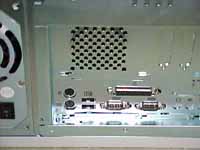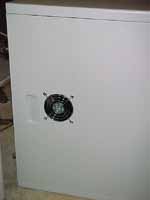A-Top AT900 Mid Tower ATX
by Mike Andrawes on January 30, 2000 11:39 PM EST- Posted in
- Cases/Cooling/PSUs
Motherboard Installation
Motherboard installation is also quite easy thanks to the slide out motherboard tray. A single tab holds the motherboard tray in place - simply lift that tab and pull back to remove the tray completely. Once removed, standoffs screw into the tray, and the motherboard is then attached to those standoffs with standard case screws. The nice thing about A-Top's motherboard tray is that it can be removed with all expansion cards still installed.
Our test bed ABIT BX6 Revision 2.0 fit without any issues and just about any single processor board should fit fine. Most smaller dual processor boards should fit fine as well, but it will be a tight squeeze. The layout of the case gives plenty of room to access all components of the motherboard, even without removing the entire motherboard tray.
Power Supply & Cooling
A Tough Power ATP250-ATX power supply puts out 250W as the primary PSU option from Atop Although it's not on AMD's Athlon Approved Power Supply List, we found that it was still a generally acceptable solution. It would easily power Test System #1 used in our AMD Athlon Buyer's Guide - Part 4: Power Supplies article, but did not fare so well with Test System #2. If your system is that powerful, consider a power supply upgrade.
An 80 mm fan exhausts air out the back of the PSU in accordance with ATX 2.01 specifications. They were wise enough to include a physical power switch on the back of the power supply that, although its not mandatory, can come in quite handy at times.
An additional 80 mm intake fan is available, but not included, in the bottom front of the case. Above the ATX I/O shield, a 40 mm exhaust fan can also be mounted to help keep the CPU just a bit cooler. Our evaluation sample featured an 80 mm exhaust fan mounted in the side panel, with a metal fan guard to prevent any lost fingers. Although it is typically not available directly from Atop with this fan, it's simple enough to cut your own hole and mount a fan in that position.
With all those fans in place, the AT900 produced quite a bit of noise at over 61dB. Further, a number of rattles were observed in our sample at points where the metal did not fit tightly together, such as the loose fitting rail system.














0 Comments
View All Comments